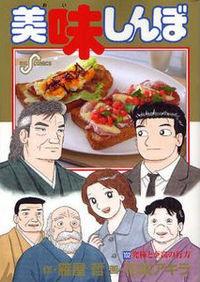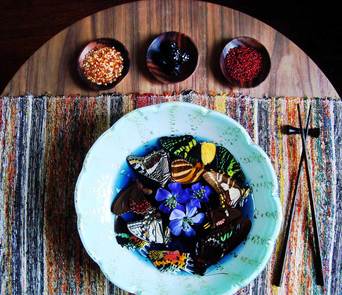
Oishinbo’s Adventure’s in Eating
Lauri Brau
Oishinbo (the manga)
Story by Tetsu Kariya
Illustrations by Akira Hanasaki
The manga starts out with intro of high lighted dishes and how to prepare them “properly” according to Japanese tradition and culture (which means that any food has to appeal to all five senses). The first chapter basically introduced us to Yamaoka and Kaibara (son and father). After reading the Oishinbo article I was expecting a manga that had to do with food - but not anything on this level! This could be more of an illustrated cookbook to some extent. When Yamaoka dips the konbu into the water to make dashi, three panels were used to show the exact steps. Not just that, though. They also explain all the reasons for why something is good or bad so you are learning a lot from it - it seems like a lot more than a manga.
I feel the gender roles are pretty prevalent. The otaku is a woman who takes the lashes from Kaibara and does things like apologize for showing emotions. Then Kurita, though she sense something is not so right with the food (or at least not as good as the others saying) she only thinks it - does not say it. There is also the part where Yamaoka speaks of his mother - how Kaibara is responsible for her death because he was demanding and unappreciative. I think this is also pretty obvious that she was an “ultimate” housewife - working so, so hard for her husband that she literally worked herself to death. I’m interested in reading on, the fun of manga but without as much guilt because you actually learn something!
The Gourmet Club
Jun’Ichiro Tanizaki
Story of Count G. and his dreams of food - he finds a traditional chinese place (Chechiang) that is not “Tokyo Restuarant” style food but “for Chinese people only”.
Creepy:
I have to admit that though it was a very interesting piece to read - it was also very grotesque. The descriptions of different kinds of food and the experiences of those foods were fascinating - completely intricate so that you could nearly taste it or at least see it before you. It brings a very aesthetic and sensual aspect to food that you might not have when just looking at something such as a pbj sandwich. I’m really not too positive on what it is all supposed to mean. I think it many ways it glorifies Chinese cuisine - while simultaneously casting its image as nearly barbaric. There was also a very comedic value to it. Everything was so extreme that the dreams and the “reality” intertwined and it all just appeared in my head as an abstract story. The end was surprising - for by the time you get to the mentioned of “Deep Fried Woman, Korean-style” you are completely ready to believe that there are men picking at the bones of a deep fried woman - though my interpretation that it is only the dough that is eaten and she is simply what the dish is served upon. Overall...I’m pretty confused other than the fact that it is making fun of the idea of a “gourmet club” by taking everything to the extreme...
Lauri Brau
- Food in Japanese media is very prevalent; food travelogues, celebrity cooking shows, films and, manga - Oishinbo specifically is gourmet food manga.
- 1970s - food had infested itself into the manga world (apprentices/athletes journeys became popular)
- These manga are often targeted towards men (men rule the professional realm of food)
- Shows readers the the array of cuisines (from other country’s to experimenting in the home)
- Japanese language’s onomatopoeia allows cooking manga to have full power (texture, tempurature, sound)
- Graphic realism
- “cultural treasure to bequeath the future” (carefully selected chefs for this assignment)
- food to the rescue
- Oishinbo acts as a “guide” in Japan for people who do not know how to make their way through so many of the cuisines available in Japan
- also focuses on Japanese “traditional” ways (how to steam rice, make miso soup etc)
- find what is right (zen in making sushi vs. arrogance and haste)
- “motenashi no kokoro” (is THE “way”)
- “the only thing thing that can move a person’s spirit is another person’s spirit...Cooking is an act of communication between souls.”
- creating food the suits the consumer - does not have to be gourmet to be good
- competitions to settle conflict - lessons taught
- rice is a “sacred symbol”
- subject of rice episodes are many (Thai rice, other rice importation issues, Japanese Mystification)
- Samurai used to be paid in rice (edo)
- fall festival circulate around rice harvest and “the soul of the Japanese”
- changes in the food industry (not as good as I remember...)
- episode on a man’s quest for “mother’s love”
- food in place of words for communication is common in Oishinbo
- no time for breakfast = impoverished Japanese society
- “What they say is certainly true: you can clearly see the condition of a society through its food”
- many sentimental stories = cultural identity
Oishinbo (the manga)
Story by Tetsu Kariya
Illustrations by Akira Hanasaki
The manga starts out with intro of high lighted dishes and how to prepare them “properly” according to Japanese tradition and culture (which means that any food has to appeal to all five senses). The first chapter basically introduced us to Yamaoka and Kaibara (son and father). After reading the Oishinbo article I was expecting a manga that had to do with food - but not anything on this level! This could be more of an illustrated cookbook to some extent. When Yamaoka dips the konbu into the water to make dashi, three panels were used to show the exact steps. Not just that, though. They also explain all the reasons for why something is good or bad so you are learning a lot from it - it seems like a lot more than a manga.
I feel the gender roles are pretty prevalent. The otaku is a woman who takes the lashes from Kaibara and does things like apologize for showing emotions. Then Kurita, though she sense something is not so right with the food (or at least not as good as the others saying) she only thinks it - does not say it. There is also the part where Yamaoka speaks of his mother - how Kaibara is responsible for her death because he was demanding and unappreciative. I think this is also pretty obvious that she was an “ultimate” housewife - working so, so hard for her husband that she literally worked herself to death. I’m interested in reading on, the fun of manga but without as much guilt because you actually learn something!
The Gourmet Club
Jun’Ichiro Tanizaki
- The Gourmet club was a group of five men who indulged in food the same way as men might indulge in women and gambling. Obsessed with fine food - but not in good health and usually laughed it off.
- Food as an ART.
- Traveling far and wide - even dreaming - for the best foods.
- Fell to boredom...needed something new and exciting (“symphony of foods, orchestral cuisine”)
Story of Count G. and his dreams of food - he finds a traditional chinese place (Chechiang) that is not “Tokyo Restuarant” style food but “for Chinese people only”.
- Though he is denied by the president of the Chechian Hall club, the man who he befriended lets him watch what happens through a hole in the wall - that viewing leads to his many culinary adventures and creativity. So Count G. made a feast for the other members and fascinated them with wonderful dishes - despite their standard Chinese cuisines names (even the burps were good...).
- Count G. considers his grand menu “Gastronomical Magic!”
- Second meal....deep fried woman korean style (batter on the flesh only is eaten)
- The Gourmet Club continued to a point where the members themselves were said to be consumed by fine cuisine.
Creepy:
- “pork loins and pigs legs...the bristles had been carefully shaven off, and the skin was as soft, white, and luscious as any woman’s. “
- “As the Count watched, spoons were thrust in from every side, and the original form of the piglet disappeared chunk by chunk, form the outside inward, as if by magic.”
- “As you know, from ancient time we Chinese have eaten swallow’s nests. We’ve eaten shark’s fins, bear’s paws, deer’s hoof sinews. But our president was the first to show us how to eat tree bark, and bird droppings, and human saliva.” ( also how to cook the food and what to put the food into)
- Though he is denied by the president of the Chechiang Hall club, the man who he befriended lets him watch what happens through a hole in the wall - that viewing leads to his many culinary adventures and creativity. So Count G. made a feast for the other members and fascinated them with wonderful dishes - despite their standard Chinese cuisines names (even the burps were good...).
I have to admit that though it was a very interesting piece to read - it was also very grotesque. The descriptions of different kinds of food and the experiences of those foods were fascinating - completely intricate so that you could nearly taste it or at least see it before you. It brings a very aesthetic and sensual aspect to food that you might not have when just looking at something such as a pbj sandwich. I’m really not too positive on what it is all supposed to mean. I think it many ways it glorifies Chinese cuisine - while simultaneously casting its image as nearly barbaric. There was also a very comedic value to it. Everything was so extreme that the dreams and the “reality” intertwined and it all just appeared in my head as an abstract story. The end was surprising - for by the time you get to the mentioned of “Deep Fried Woman, Korean-style” you are completely ready to believe that there are men picking at the bones of a deep fried woman - though my interpretation that it is only the dough that is eaten and she is simply what the dish is served upon. Overall...I’m pretty confused other than the fact that it is making fun of the idea of a “gourmet club” by taking everything to the extreme...

 RSS Feed
RSS Feed